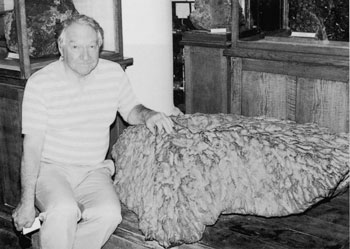
This Article From Issue
July-August 2002
Volume 90, Number 4
DOI: 10.1511/2002.27.0
Meteorite Hunter: The Search For Siberian Meteorite Craters. Roy A. Gallant. l + 231 pp. McGraw-Hill, 2002. $24.95.
A casual look through a telescope aimed at the moon reveals more than 30,000 craters on the side facing Earth. For 300 years after the invention of the telescope, astronomers believed that these were the product of volcanism. This erroneous idea persisted well into the 20th century; only about 20 years before the first Apollo flight to the moon was it realized that they had instead been formed by the impact of meteorites. But a nagging question persisted among geologists: If the moon was covered by impact craters, where were the earthly counterparts?
At mid century only one crater (Meteor Crater in Arizona) was suspected of having been formed by the impact of an iron meteoritic body. It took time to work out the physics of impacting bodies and to develop the criteria needed for definitive proof of a terrestrial crater's extraterrestrial origin. Then the search began for these ancient scars. As we enter the 21st century, we know of about 170 impact craters on Earth in various states of preservation. They are found in every environment, on every continent save Greenland (although large iron meteorites have been recovered there) and on the ocean floor. Many have been discovered by orbiting spacecraft imaging Earth from hundreds of miles in space. But the only way to prove that these ancient scars are meteoritic is to visit them in person and look for the now well-understood signs of an impact origin.

From Meteorite Hunter.
Meteorite Hunter is the story of author Roy A. Gallant's personal odyssey through Siberia, visiting the best impact craters and meteorite fall sites along the way. An astronomer and science writer, Gallant is deeply involved with the subject on a personal level and has sought out the latest, most thorough information. The meteorites and craters he pursued are well known and have been thoroughly studied by Russian scientists, many of whom he wisely employed as his guides. (Their assistance is noted in the acknowledgments.)
Surprisingly, what is most captivating and appealing about this book does not involve the crater sites Gallant visits or the meteorites he gathers. Rather, it is the difficult and frustrating problems he encounters traveling through remote Siberia in the post-Soviet era. It is his incredible good fortune to be introduced to a young interpreter for the Russian government named Katya, who not only knows the Russian language and Russian customs but is also an authority on the mysterious Tunguska Event of 1908, in which an explosion near the Vanavara trading post on the Stony Tunguska river in Central Siberia blew down the forest for hundreds of square kilometers. Katya knows the principal investigators of the site and volunteers to accompany Gallant there. Gallant's travels begin in the summer of 1992 and continue through eight summers, as he and Katya visit the Sikhote-Alin meteorite-strewn field in far Eastern Siberia, the Chinga meteorite fall site, the famous Pallas stony-iron meteorite discovery site and the Popigai impact crater site far above the Arctic Circle.
This is not primarily a book about impact physics or meteoritical science; it is an adventure story. The human element overpowers all other considerations. The heroine of the story is Katya, who keeps Gallant out of trouble, makes all the necessary arrangements and acts as representative for the entire group, Russians included. Without her, the vehicles would not have been there when needed, the helicopters would not have arrived, trains would have been missed and swindlers would have had most of Gallant's money. The difficulties she overcomes are a sad commentary on the state of affairs in post–Soviet Russia. Getting to the sites and surviving once there are real challenges. Gallant's descriptions of his experiences far from the comforts Americans have grown to expect are not soon to be forgotten.
The final chapter, "Target Earth," rather abruptly departs from the wild Siberian taiga, discussing in some detail the impact of large asteroidal bodies energetic enough to cause the extinction of life. Only one crater in Siberia is large enough to suggest that it may have produced extinctions. This topic, which has been widely discussed, would have been better left to an entirely separate book, where Gallant could do a good job with the subject.—O. Richard Norton, Bend, Oregon (former director, Grace H. Flandrau Planetarium and Science Center, University of Arizona, Tucson)
American Scientist Comments and Discussion
To discuss our articles or comment on them, please share them and tag American Scientist on social media platforms. Here are links to our profiles on Twitter, Facebook, and LinkedIn.
If we re-share your post, we will moderate comments/discussion following our comments policy.